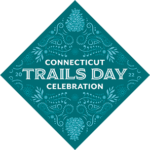Ring in the new year outdoors with friends and neighbors! Our third annual First Day Hike at Wintonbury Hills Golf Course, co-sponsored with Bloomfield Parks, Recreation, and Leisure Services, will explore the Town of Bloomfield’s picturesque golf course abutting the Land Conservancy’s Beacon Hill Preserve. Some of the property along Duncaster Road once was part of A. C. Peterson Farms and nicely illustrates the rural character of western Bloomfield. As a result of continuing, thoughtful management it is certified as a Cooperative Bird Sanctuary by Audubon International.
This guided walk will follow approximately 2.5 miles of cart paths over the rolling hills. Leashed dogs are welcome. Please use the online RSVP form to help our volunteer event leaders plan ahead. Thank you!
When Wintonbury Hills closes to golfers for the season, walkers are welcome to use the grounds as long as they stay on the cart paths. Snowshoeing also is allowed once there is snow. Take advantage of this opportunity to explore one of Bloomfield’s nicest walks and wonderful views.
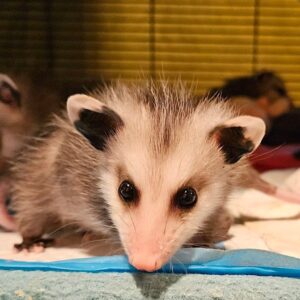 While we may only catch a glimpse of one late at night, these backyard neighbors play an important role in helping to control pest insect populations such as ticks. Plus, they are the only marsupial native to North America!
While we may only catch a glimpse of one late at night, these backyard neighbors play an important role in helping to control pest insect populations such as ticks. Plus, they are the only marsupial native to North America!
Ferncroft Wildlife Rescue will teach us about Opossums and their benefits during this presentation co-sponsored by Traprock Ridge Land Conservancy and East Granby Public Library. After the all-ages presentation, there will be an opportunity to meet one of the Opossum in Ferncroft’s care.
Please register in advance for free through the library.
We will be making a 1.5 ft small wood tree by up-cycling the invasive Asian bitter sweet vines that we have cut while making trails. Register at egpl.org Co-sponsored by East Granby Public Library
When Traprock Ridge Land Conservancy helped East Granby Public Library create Doreen’s Nature Trail behind the library, an invasive vine called Asian Bittersweet was cut … and saved.
We can take these invasive vines and up-cycle them into a beautiful decoration for your home. In this free, hands-on craft workshop we will drill and mix-and-match slices of bittersweet wood to create truly unique, 1.5 foot “trees” to take home.
Register online through our co-sponsor, East Granby Public Library.
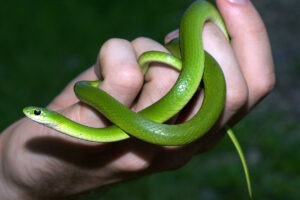


Are any of the snakes in Connecticut dangerous to humans? How do they survive the winter? What role do they play in our environment? Join us for a talk with Brian Kleinman, owner of Riverside Reptiles Education Center, to answer these questions and more about the 14 snake species native to Connecticut.
Brian’s presentation is perfect for all ages: He will present on the natural history and identification of our local snakes, and you will have the opportunity to meet and touch some of the live snakes in the center’s collection!
This program is free; no registration required. Co-sponsored by Traprock Ridge Land Conservancy and Riverside Reptiles Education Center.
(Photo: Smooth Green Snake, courtesy Riverside Reptiles Education Center)
Enjoy an invigorating hike from Bloomfield to Simsbury co-sponsored by the Traprock Ridge Land Conservancy (TRLC), Simsbury Land Trust (SLT), and Bloomfield Parks, Recreation & Leisure Services. Along with the glorious fall scenery, the free hike will showcase TRLC, SLT, and town properties that provide trail connectivity linking Bloomfield and Simsbury through Penwood State Park.
The hike will be approximately 5 miles. Meet at 9:00 a.m. at the hike’s end point, the parking lot at the corner of Iron Horse Boulevard and Drake Hill Road in Simsbury (Google map). Bloomfield Parks, Recreation & Leisure Services will provide a bus to shuttle hikers to this year’s starting point, the Oliver Filley House in Bloomfield’s LaSalette Park.
We will hike from LaSalette Park to TRLC’s adjoining Hawk Hill Farm, a working farm with passive recreation trails. From there we will proceed to TRLC’s Stout Family Fields, Bloomfield’s alternate gateway to Penwood State Park.
In Penwood, we’ll visit Lake Louise and The Pinnacle before taking the yellow trail to access SLT’s adjacent Tanager Hill preserve for a lovely descent from Penwood State Park into Simsbury. We’ll proceed through SLT’s Owen-Mortimer preserve and return to the parking lot.
We invite you to take advantage of this annual opportunity to experience a different mode of journeying between our two neighboring towns and enjoy the end of the fall color. RSVP online to help us plan ahead. Thank you!
(Photos from last year courtesy Paula Jones.)
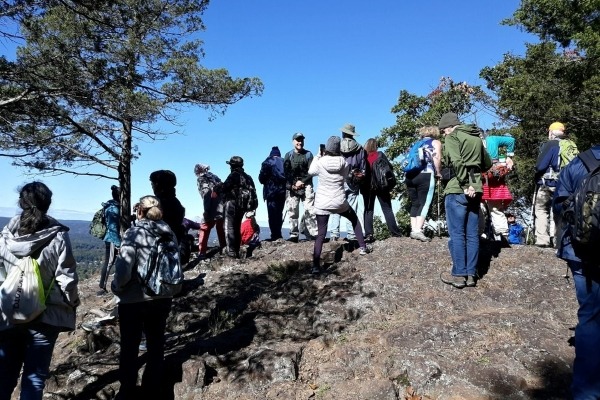


Views from the Pinnacle in Penwood State Park
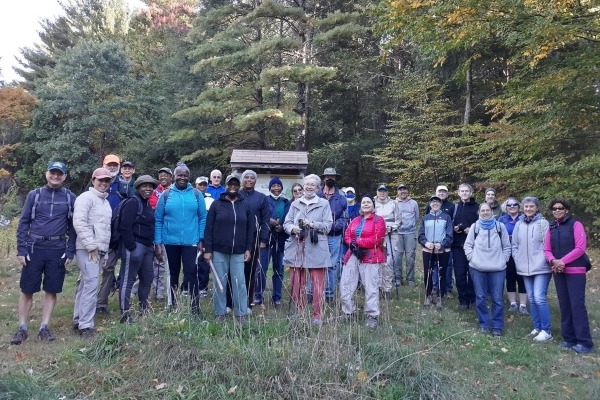


Gathering at Simsbury Land Trust’s Tanager Hill Preserve
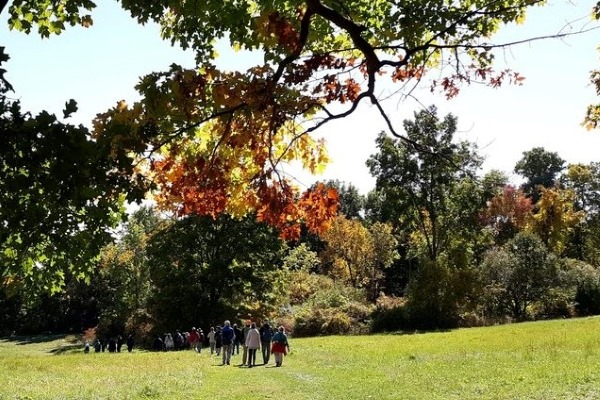


Hikers cross Wintonbury Land Trust’s Stout Family Fields
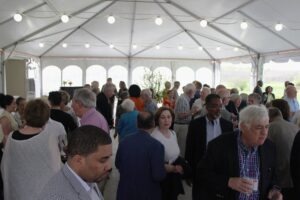


We’re celebrating the new Traprock Ridge Land Conservancy formed in April 2023 by the merger of the East Granby, West Hartford, and Wintonbury (Bloomfield) land trusts. We also want to thank the many helpers and supporters who made the merger possible.
Please join us to socialize with neighbors who love the outdoors and share our mission of preserving open space and farmland within our communities:
- Enjoy live music, hors d’oeuvres, sodas, beer, and wine (or additional drinks from a cash bar).
- Learn about the merger and our accomplishments since then.
- Discover new places for nature walks, and learn how you can help us protect open space.
Event registration for refreshments and drinks is $25 per person for members and $30 per person for non-members. Additional contributions are welcome (we are a 501c3 tax-exempt organization).
Please register by Friday, September 15:
- Register & contribute online now with a credit card. (Registration now is closed.)
- Or download and print a PDF form to mail-in with a check.
Event Sponsors:
- Richard P. Garmany Fund at the Hartford Foundation for Public Giving
- Seabury Life
- White & Katzman Property Services
- The Bluebird Fund at the Hartford Foundation for Public Giving
- Northwest Community Bank
- Windsor Federal
Learn how you or your organization can co-sponsor this event to help our land trust members learn about the merger and support land conservation efforts in our communities: sponsorship fact sheet.
Preparation in the Fall can drastically impact the tick population in your yard next Spring. Horticulturalist and organic land care steward David Murray will discuss simple techniques to help everyone reduce the risks of tick-borne diseases.
In this free workshop, David will examine how ticks in our yards impact our lives. He also will show us how to use simple supplies – toilet paper tubes and a low toxicity insecticide – to safely and effectively reduce tick populations along tree, shrub, and woodland borders.
This presentation is cosponsored by the Traprock Ridge Land Conservancy and East Granby Public Library.
You’re welcome to attend Board of Directors meetings to learn about the organization or to get more involved. This month we will be at East Granby Public Library. Please contact us if you have questions or suggestions for the agenda.
You’re welcome to attend Board of Directors meetings to learn about the organization or to get more involved. This month we will be at East Granby Public Library. Please contact us if you have questions or suggestions for the agenda.
Come explore the Town of Bloomfield’s Wilcox Park and a portion of the Metacomet Trail atop the region’s traprock ridge that connects Bloomfield to East Granby to the north and West Hartford to the south. We will follow the yellow trail through the meadow, over a brook, through the woods, and past a vernal pool to connect with the blue-blazed Metacomet Trail along the ridgeline. While taking in views of the Farmington River Valley to the west, we will proceed to the Buck Property recently donated as an addition to the park before descending to the start. The approximately 3 mile route is moderately difficult, and leashed dogs are permitted. The rain date is Sunday, June 4. RSVP is appreciated.
